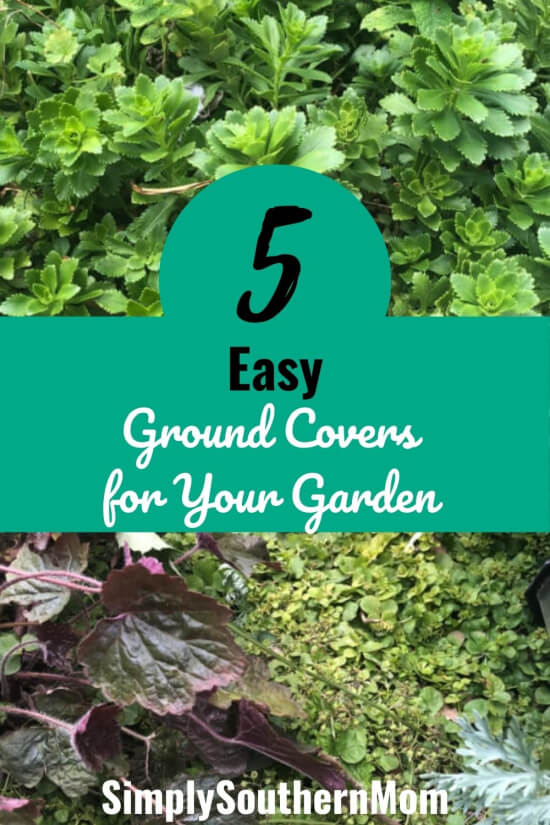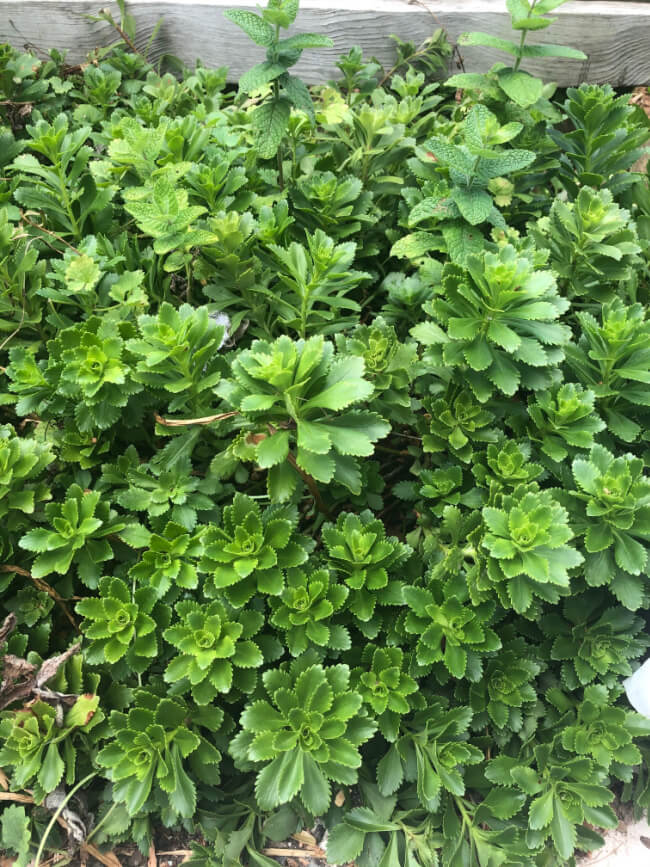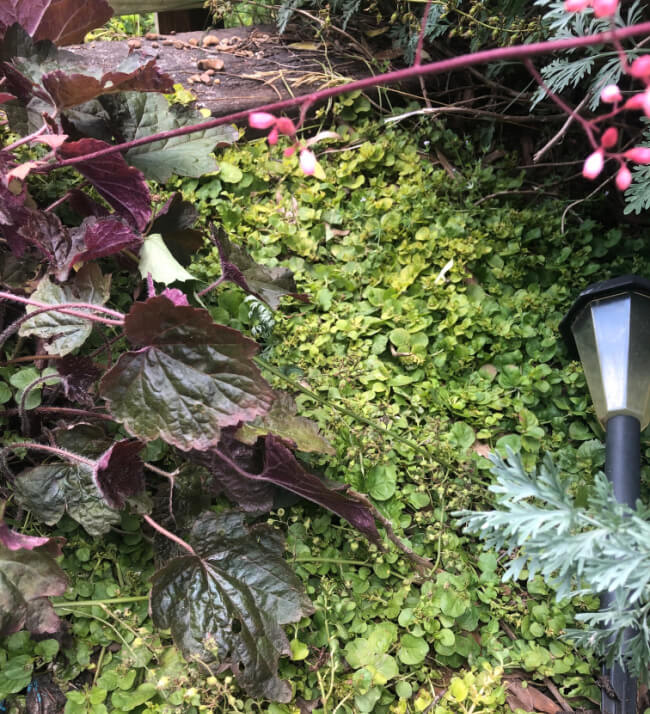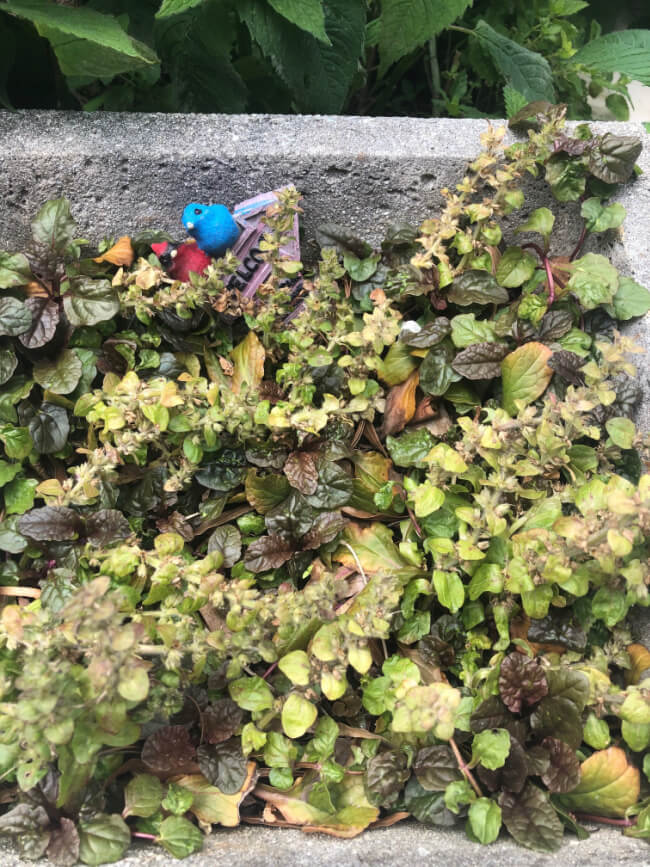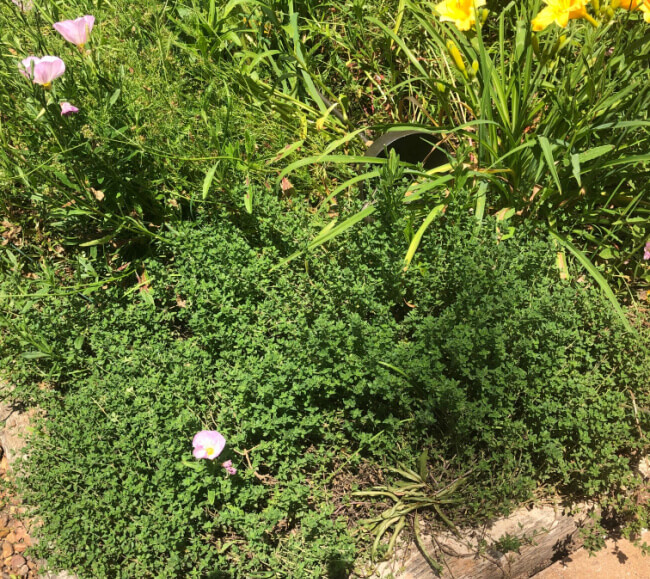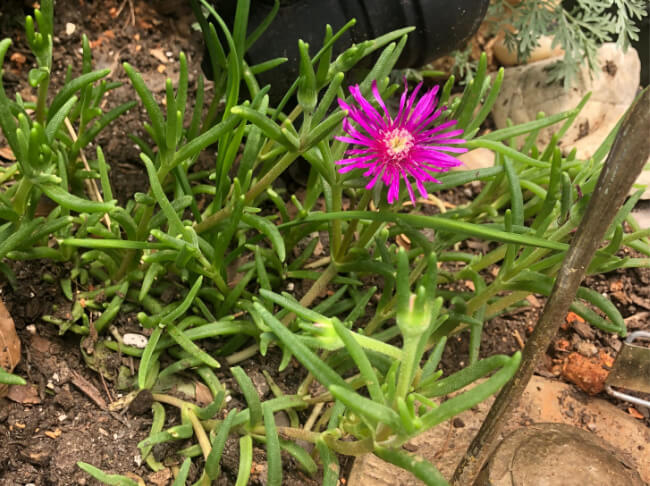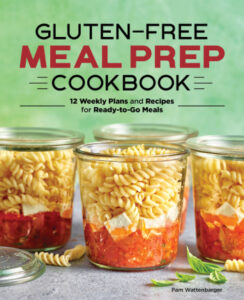This year, in either a fit of inspiration or over-confidence, I decided to redo my patio. I wanted a lush, tropical feel with plenty of greenery. I have a 6-to-8 inch gap between the patio and the fence I needed to fill with low-lying plants that wouldn’t harbor any small critters like skunks and snakes. Yes, that’s actually a problem in my backyard! I’m also picky about my ground cover. I want something that comes back year after year, is low-maintenance, and spreads to cover the entire area. Here are my favorite 5 Easy to Grow Groundcovers for Borders.
5 Easy to Grow Groundcovers for Borders
My preference is to purchase perennials since they usually spread and they come back year after year. Perennials do require patience as it takes them a few years to spread and fill in an area. I usually suggest planting perennials and then filling in with a few annuals the first couple of years to add color.
Sedum
1. Sedum Varieties –
I added one of my favorite easy-to-grow plants, sedum. As one of the instructors in my Master Gardener class said, “All you need to grow sedum is to place it on the ground and stomp it in.” While I wouldn’t go that far, it is a low-maintenance plant that tolerates our scorching Georgia summers and likes dry, rocky areas. I use this in borders, hanging baskets, planters, or wherever I need a hardy perennial.
Some of the species can grow over to over three feet, but other varieties are best planted as groundcovers. My choices included:
- Sedum album ‘Murale’– This variety has bronze foliage and pink flowers that bloom in early summer. It’s suitable for zones 3-9, grows 2 to 3 inches tall, and attracts butterflies. Plant it in full sun.
- Blue Spruce’ Sedum (Sedum reflexum ‘Blue Spruce’ or S. rupestre ‘Blue Spruce’- It has bluish needle-like foliage resembling that of some evergreen shrubs. It’s hardy in zones 4-9, grows 4 to 8 inches tall, and enjoys full sun.
- “Angelina’ Stonecrop (Sedum rupestre ‘Angelina’) has gold leaves that turn bronze in cool or cold weather, along with tiny yellow flowers in the summer. It’s hardy in zones 3-9, grows between 4-6 inches tall and can be planted in the sun or partial shade.
- Weihenstephaner Gold (Sedum kamtschaticum ‘Weihenstephaner Gold’)- This heat and drought tolerant variety repels deer and rabbits, grows 6-inches tall, and has lovely yellow flowers. It’s hardy in zones 3 to 8.
Creeping Jenny
2. Creeping Jenny– (Lysimachia nummularia: “Moneywort” Sometimes called Moneywort, is a perennial member of the primrose family that usually stays evergreen all year. The plant grows 2 to 4 inches in height, spreads 1 to 2 feet, and makes a thick mat-like covering. I’ve found it grows well in part-shade and full sun. The leaves are a golden lime color and the plant will form yellow flowers in the summer.
Note: Moneywort is considered invasive in some states so plant in a controlled area to prevent it from spreading over native plants and grasses. It’s recommended to plant this in raised beds, planters, or in hanging baskets. Whenever I find it growing in an unwanted spot, I pull it up.
Bugle Weed
3. Bugle Weed- (‘Ajuga reptans)- might also be found as ajuga, bugleweed, Blue Bugle, Carpet Bugle, or Bugle Herb. Whew! That’s a lot of names. This plant has a lot going for it! It’s resistant to deer and rabbits, tolerates sandy or clay soil, and attracts hummingbirds, songbirds, and bees. It grows between 6 to 12 inches tall, has glossy green, purple, or gray leaves (depending on the cultivar), and beautiful bluish-purple flowers in spring.
It provides a dense mat of foliage that stays evergreen all year. On the downside, it can be considered invasive as its a fast-spreader. It is a member of the mint family, after all!
Thyme-
4. Thyme- Available in several varieties, this plant adds fragrance to any area of the garden. It likes full sun and well-drained soil and different varieties can grow from 2 to 15 inches high. If you allow the plants to flower, they will attract bees. I’m all about my pollinators! Grow thyme in zones 5-9. This noninvasive plant will tolerate “light foot traffic” so if you or one of the kids step on it every once in a while it will be fine. Here’s a few of my favorite varieties:
- English Thyme– low growing, fragrant, and can be used in cooking and in soap making.
- Woolly thyme (T. pseudolanuginosus) –has soft silver leaves which look and feel ‘woolly.’ This variety rarely flowers so it is less attractive to bees. Grows to only 1/2 to 1 inch in height and slowly spreads. Usually not considered a culinary variety.
- Lemon Thyme– grows up to 1 foot tall, likes full sun, and smells like lemon. It can be used in any recipe calling for lemons, lemon juice, or lemon zest.
Cooper’s Hardy Ice Plant-
5. Cooper’s Ice Plant (Delosperma cooperi)– This bee friendly, deer-resistant plant blooms for over a month in summer with magenta flowers. It likes full sun and tolerates sandy or average soil. While the plant is said to spread to 1 to 2 feet and 18 inches tall, my plants have only averaged around 6 inches in height. Choose this plant for any zone between 5-9.
Gardening Terms You Need to Know:
- Full Sun– If a plant needs full sun, plant it in an area that will receive 4-to-6 hours of daily sunlight.
- Partial Shade– These plants need 3 to 6 hours of direct sunlight per day but need to be protected from the afternoon heat.
- Partial Sun- This usually means the plant is more heat tolerant than partial-shade plants and can handle more direct sun exposure.
- Shade-These plants need less than 6 hours of sunlight a day. They prefer morning sun over scorching afternoon sun. They *usually* can grow under trees or bushes where some sunlight will filter through.
- Perennial– a plant that comes back every year.
- Annual– a plant that only blooms one season.
- Biennial-a plant which blooms in its second year and then dies.
Remember, the sun’s ray will be hotter in some parts of the US (the Southeast, Southwest, and West.) If you live in these climates, plants will need more protection from the midday and afternoon sun, along with more frequent watering.
I hope these 5 Good Low Growing Perennial Plants help enliven your garden and borders as much as they do mine. What are some of your favorite groundcovers?
